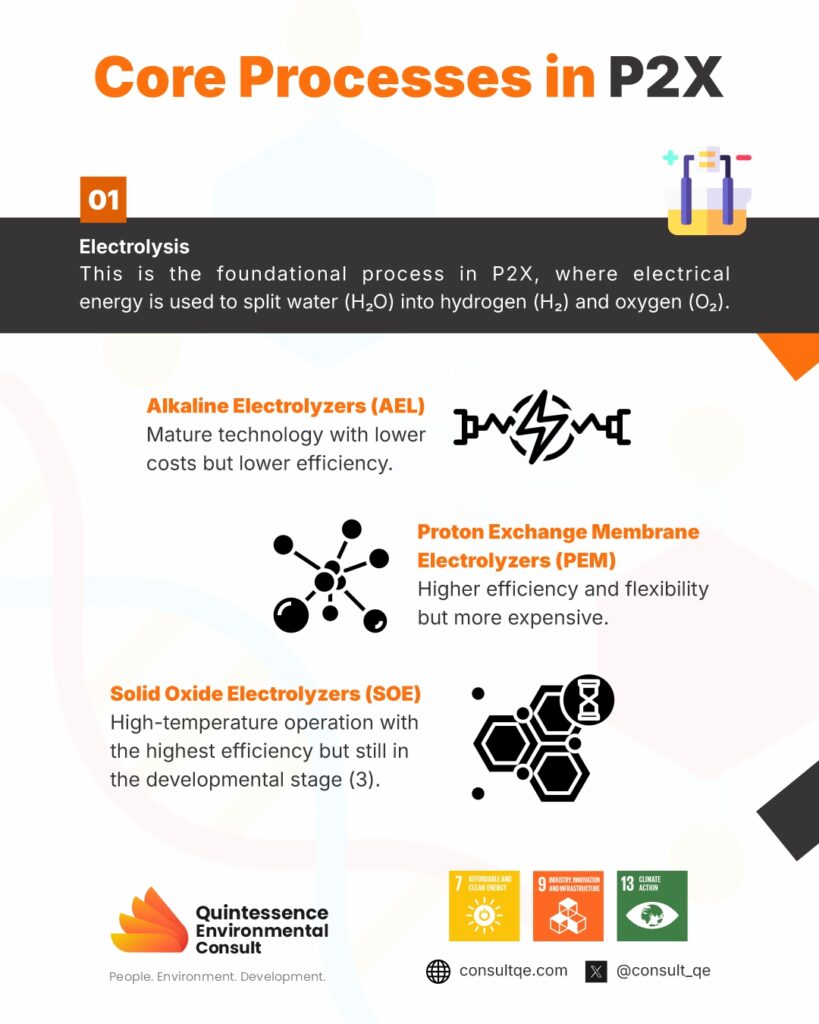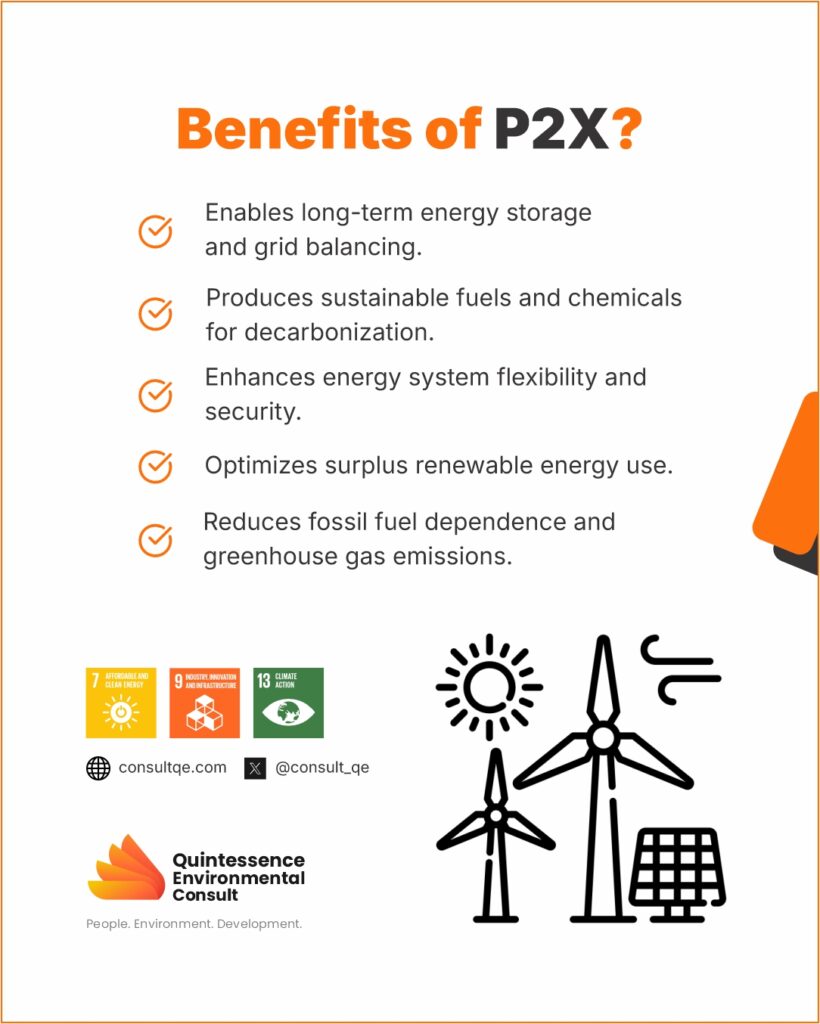- Renewable Energy Utilization: P2X technology can harness Nigeria’s vast solar and wind resources to produce green hydrogen, ammonia, and synthetic fuels, enhancing energy security and sustainability.
- Energy Storage & Grid Stability: It enables long-term energy storage and grid balancing by converting excess renewable electricity into hydrogen and other energy carriers.
- Industrial Growth: Adoption of P2X can drive job creation, boost industrial development, and position Nigeria as a key player in the global hydrogen market.
- Decarbonization & Climate Goals: It supports Nigeria’s commitment to the Paris Agreement by reducing carbon emissions in industries like transportation, manufacturing, and agriculture.
- Recommendation: High initial costs, infrastructure gaps, and regulatory challenges must be addressed through national hydrogen strategies, investment in research, and workforce training.
Nigeria’s energy sector faces a complex interplay of factors: a heavy dependence on fossil fuels, a rapidly increasing demand for electricity, and a wealth of untapped renewable energy potential. This convergence of circumstances creates exciting opportunities and significant hurdles for adopting innovative energy technologies. As Nigeria strives for a sustainable energy future, these emerging technologies have the potential to revolutionize the nation’s energy landscape. Power-to-X (P2X) stands out as a particularly promising solution. P2X encompasses a range of cutting-edge technologies that transform excess renewable electricity into valuable energy carriers like hydrogen, ammonia, and synthetic fuels. This capability offers solutions to several pressing challenges, including stabilizing the power grid, providing large-scale energy storage, and decarbonizing various sectors of the economy. These solutions are not only vital for bolstering Nigeria’s energy security but are also crucial for achieving its industrial growth objectives(3,7). This blog post will delve into the specific opportunities and challenges that P2X presents within the Nigerian context.

- Electrolysis
- Alkaline Electrolyzers (AEL): Mature technology with lower costs but lower efficiency.
- Proton Exchange Membrane Electrolyzers (PEM): Higher efficiency and flexibility but more expensive.
- Solid Oxide Electrolyzers (SOE): High-temperature operation with the highest efficiency but still in the developmental stage (3).
- Synthesis
- Methanation: Hydrogen reacts with CO₂ to produce synthetic methane (CH₄), a renewable alternative to natural gas.
- Fischer-Tropsch Synthesis: Converts hydrogen and CO₂ into liquid hydrocarbons, such as synthetic diesel or jet fuel.
- Haber-Bosch Process: Combines hydrogen with nitrogen to produce ammonia (NH₃), a key component in fertilizers and a potential energy carrier. (2)
KEY P2X PATHWAYS
P2X technologies can be categorized into several pathways based on the end product (6):
|
Pathway
|
Description
|
Applications
|
|---|---|---|
|
Power-to-Gas (P2G)
|
Converts renewable electricity into gaseous fuels like hydrogen and methane. |
Hydrogen production, Grid balancing, synthetic methane for heating and transportation. |
|
Power-to-Liquids (P2L)
|
Produces liquid fuels such as synthetic diesel and jet fuel. |
Aviation, shipping, and heavy-duty transportation |
|
Power-to-Chemicals (P2C)
|
Enables the production of chemicals like ammonia and methanol. |
Fertilizers, industrial chemicals, and energy carriers. |
|
Power-to-Heat (P2H)
|
Converts electricity into heat for industrial or district heating systems |
Industrial processes and residential heating. |

- Germany’s Energiewende: Germany has invested heavily in P2X technologies as part of its energy transition strategy, with projects like the Hybrid Power Plant in Prenzlau integrating wind energy with hydrogen production, the GETH Nucleus Project (300 MW Capacity 2027), and the Green Wilhelmshaven Project (1 GW electrolyzer capacity by 2028) (2).
- South Africa: Hydrogen South Africa (HySA) initiative focuses on green hydrogen for export (4).
- Saudi Arabia: NEOM project aims to produce 650 tons of green ammonia daily using solar and wind energy.
- Japan’s Hydrogen Society: Japan has set ambitious targets to become a hydrogen-based economy, leveraging P2X technologies to produce green hydrogen and ammonia (5).
WHY DOES P2X MATTER FOR NIGERIA? Nigeria’s energy landscape is at a pivotal juncture, with Power-to-X (P2X) technologies emerging as a transformative force in the nation’s pursuit of sustainable and resilient energy solutions. Globally, countries are investing heavily in P2X technologies to decarbonize their economies and enhance energy security. For instance, Germany has initiated significant research projects into P2X options, recognizing their potential to integrate renewable energy across sectors (2). Nigeria, endowed with abundant renewable resources, is well-positioned to leverage P2X technologies. The nation’s substantial solar radiation and wind potential provide a solid foundation for generating the renewable electricity necessary for P2X processes. By converting this renewable energy into various forms, Nigeria can address energy storage challenges, reduce greenhouse gas emissions, and stimulate economic growth (1).
- Energy Storage and Grid Stability
- Decarbonization and Climate Goals
- Industrial Development and Job Creation
OPPORTUNITIES FOR NIGERIA
Nigeria stands to gain immensely from adopting P2X technology. Key advantages include:
- Harnessing Vast Renewable Resources: With approximately 5.5 kWh/m²/day of solar radiation and strong wind potential in the northern regions, Nigeria can generate the electricity needed for large-scale hydrogen production (6).
- Developing an Export Market for Green Hydrogen: European and Asian markets are increasingly investing in hydrogen imports, and Nigeria could become a major supplier/exporter, leveraging its renewable energy potential similar to what Morocco and Namibia are developing (4).
- Supporting the Global Shift to Clean Fuels: The maritime industry is moving towards zero-carbon fuels, and green ammonia produced through P2X processes in Nigeria could play a crucial role in this transition, thereby also enhancing the potentiality of a large and small-scale generation of hydropower (8).
- Agriculture: Power-to-X (P2X) technology holds significant potential to enhance agriculture in Nigeria by enabling the production of green ammonia, a key component in fertilizers. Currently, Nigeria imports over 60% of its fertilizer needs, which strains foreign reserves and limits agricultural productivity. By leveraging P2X, Nigeria can produce green ammonia locally using renewable energy sources like solar and wind, reducing reliance on imports and lowering costs for farmers. Green ammonia is produced through the Haber-Bosch process, which combines hydrogen (generated via electrolysis) with nitrogen. This sustainable approach not only supports food security but also aligns with Nigeria’s climate goals by reducing carbon emissions associated with traditional fertilizer production. Additionally, green ammonia can serve as a clean energy carrier for powering agricultural machinery, further decarbonizing the sector. By adopting P2X, Nigeria can transform its agricultural landscape, boosting productivity, reducing costs, and contributing to a more sustainable and resilient food system (6,8).

CHALLENGES IN P2X IMPLEMENTATION
Despite the opportunities, several hurdles need to be addressed:
- High Initial Investment Costs: Establishing electrolyzers, storage systems, and related infrastructure requires substantial capital investment.
- Limited Hydrogen Infrastructure: Nigeria’s current energy grid and storage facilities require significant upgrades to accommodate hydrogen production and distribution.
- Regulatory Gaps: The country lacks a comprehensive policy framework to support hydrogen and P2X technology deployment.
- Skilled Workforce Shortage: There is a need for specialized training programs to develop expertise in hydrogen technology and synthetic fuel production.
STRATEGIC RECOMMENDATIONS FOR NIGERIA
To fully harness the potential of P2X technologies, Nigeria should consider the following strategic actions:
- Develop a National Hydrogen Strategy: Formulate a clear roadmap with defined goals and timelines to guide the development and integration of P2X technologies across sectors.
- Invest in Infrastructure and Research: Allocate resources to build the necessary infrastructure and support research initiatives to drive innovation and facilitate the deployment of P2X solutions.
- Foster Public-Private Partnerships: Encourage collaborations between government entities and private sector stakeholders to mobilize investment, share risks, and accelerate the commercialization of P2X technologies (5).
- Implement Supportive Policies and Incentives: Establish policies that encourage the adoption of P2X technologies, such as tax incentives and subsidies, to stimulate market growth and attract investment.
- Enhance Workforce Training and Education: Develop specialized training programs to equip the workforce with the skills needed to operate and maintain P2X systems, ensuring sustainable growth in this emerging sector.
CONCLUSION
Power-to-X (P2X) presents transformative opportunities for Nigeria’s energy, industrial, and agricultural sectors. By leveraging renewable energy resources, Nigeria can produce green hydrogen, ammonia, methanol, and synthetic fuels to: Support economic diversification, create jobs and new industries, reduce carbon emissions, and strengthen Nigeria’s global energy leadership.
The time is right for Nigeria to act decisively and position itself as a leader in the global transition to clean energy.
REFERENCES
- Ajayi, O.O., Fagbenle, R.O., and Katende, J. (2010) ‘Wind Energy Potential in Nigeria’, Renewable Energy Journal.
- DENA (2021) Power-to-X: A Key Technology for the Energy Transition. German Energy Agency.
- DOE (2021) Industrial Decarbonization Roadmap. U.S. Department of Energy.
- Hydrogen Council (2023) Hydrogen Insights Report.
- IEA (2022) The Future of Hydrogen: Seizing Today’s Opportunities. International Energy Agency.
- IRENA (2021) Green Hydrogen: A Guide to Policy Making. International Renewable Energy Agency.
- IRENA (2023) Global GIS-based Potential Analysis and Cost Assessment of Power-to-X Fuels in 2050. International Renewable Energy Agency.
- Lloyd’s Register (2021) Ammonia as a Marine Fuel: Future Trends in Shipping.
- Nigeria NDC Report (2021) Nationally Determined Contributions for Nigeria under the Paris Agreement.
- U.S. DOE (2020) Clean Energy Infrastructure and Job Creation. U.S. Department of Energy.

Awesome
The opportunities are enormous but first, we must dare to dream!